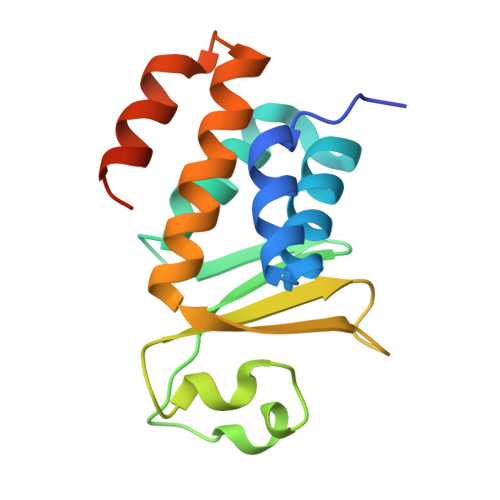The structure of a contact-dependent growth-inhibition (CDI) immunity protein from Neisseria meningitidis MC58.
Tan, K., Johnson, P.M., Stols, L., Boubion, B., Eschenfeldt, W., Babnigg, G., Hayes, C.S., Joachimiak, A., Goulding, C.W.(2015) Acta Crystallogr F Struct Biol Commun 71: 702-709
- PubMed: 26057799
- DOI: https://doi.org/10.1107/S2053230X15006585
- Primary Citation of Related Structures:
4Q7O - PubMed Abstract:
Contact-dependent growth inhibition (CDI) is an important mechanism of intercellular competition between neighboring Gram-negative bacteria. CDI systems encode large surface-exposed CdiA effector proteins that carry a variety of C-terminal toxin domains (CdiA-CTs). All CDI(+) bacteria also produce CdiI immunity proteins that specifically bind to the cognate CdiA-CT and neutralize its toxin activity to prevent auto-inhibition. Here, the X-ray crystal structure of a CdiI immunity protein from Neisseria meningitidis MC58 is presented at 1.45 Å resolution. The CdiI protein has structural homology to the Whirly family of RNA-binding proteins, but appears to lack the characteristic nucleic acid-binding motif of this family. Sequence homology suggests that the cognate CdiA-CT is related to the eukaryotic EndoU family of RNA-processing enzymes. A homology model is presented of the CdiA-CT based on the structure of the XendoU nuclease from Xenopus laevis. Molecular-docking simulations predict that the CdiA-CT toxin active site is occluded upon binding to the CdiI immunity protein. Together, these observations suggest that the immunity protein neutralizes toxin activity by preventing access to RNA substrates.
- Midwest Center for Structural Genomics, Argonne National Laboratory, Argonne, IL 60439, USA.
Organizational Affiliation:


















